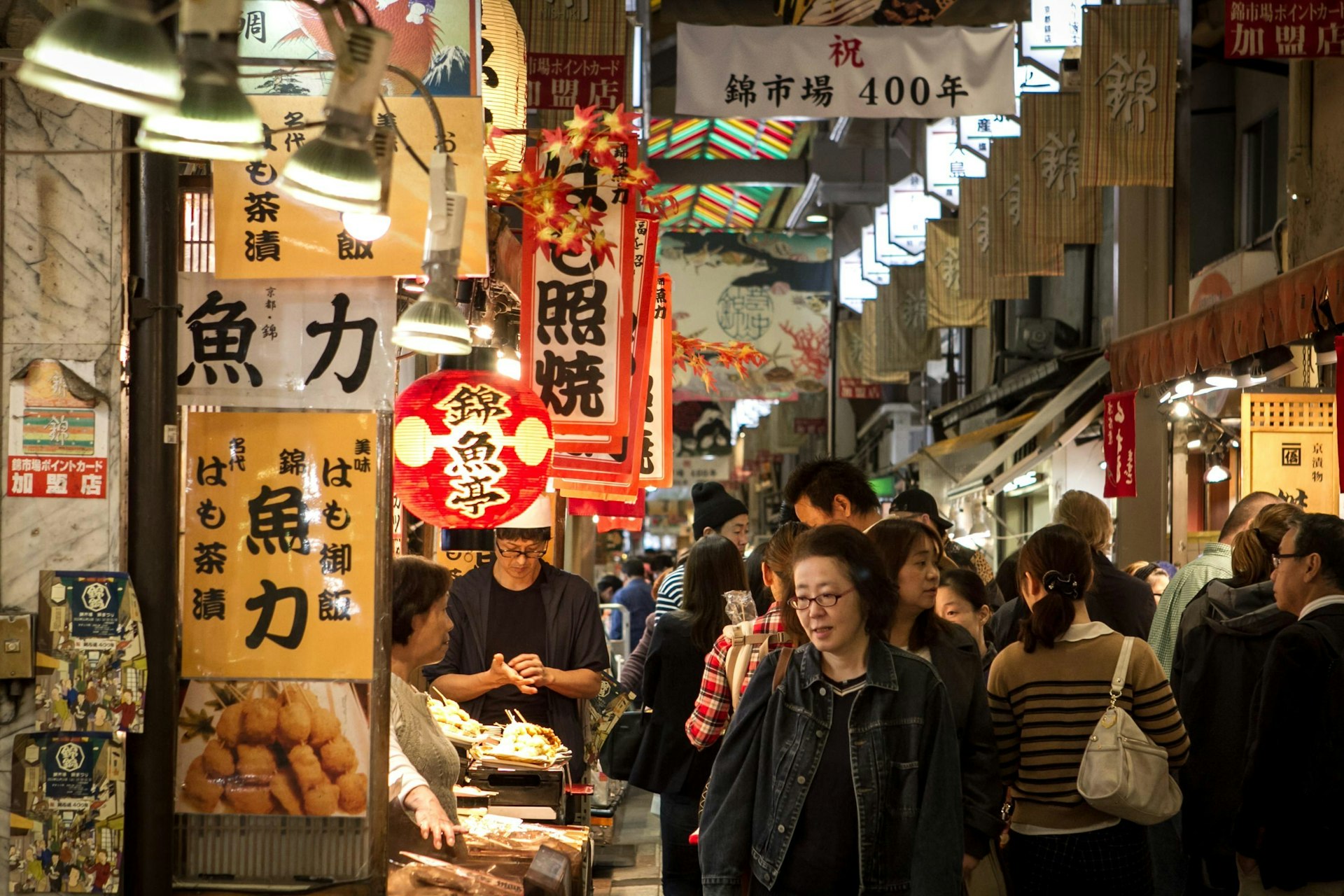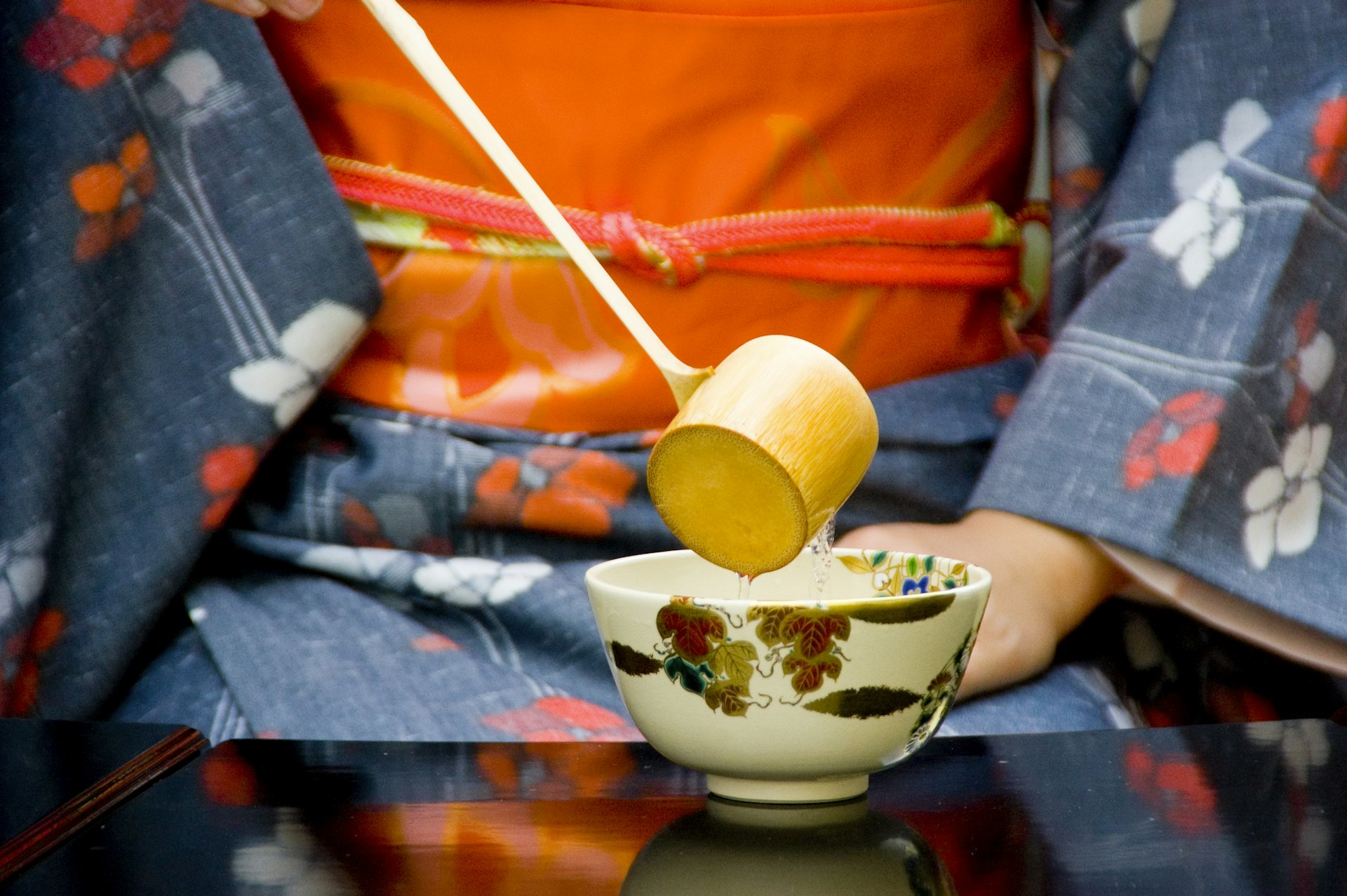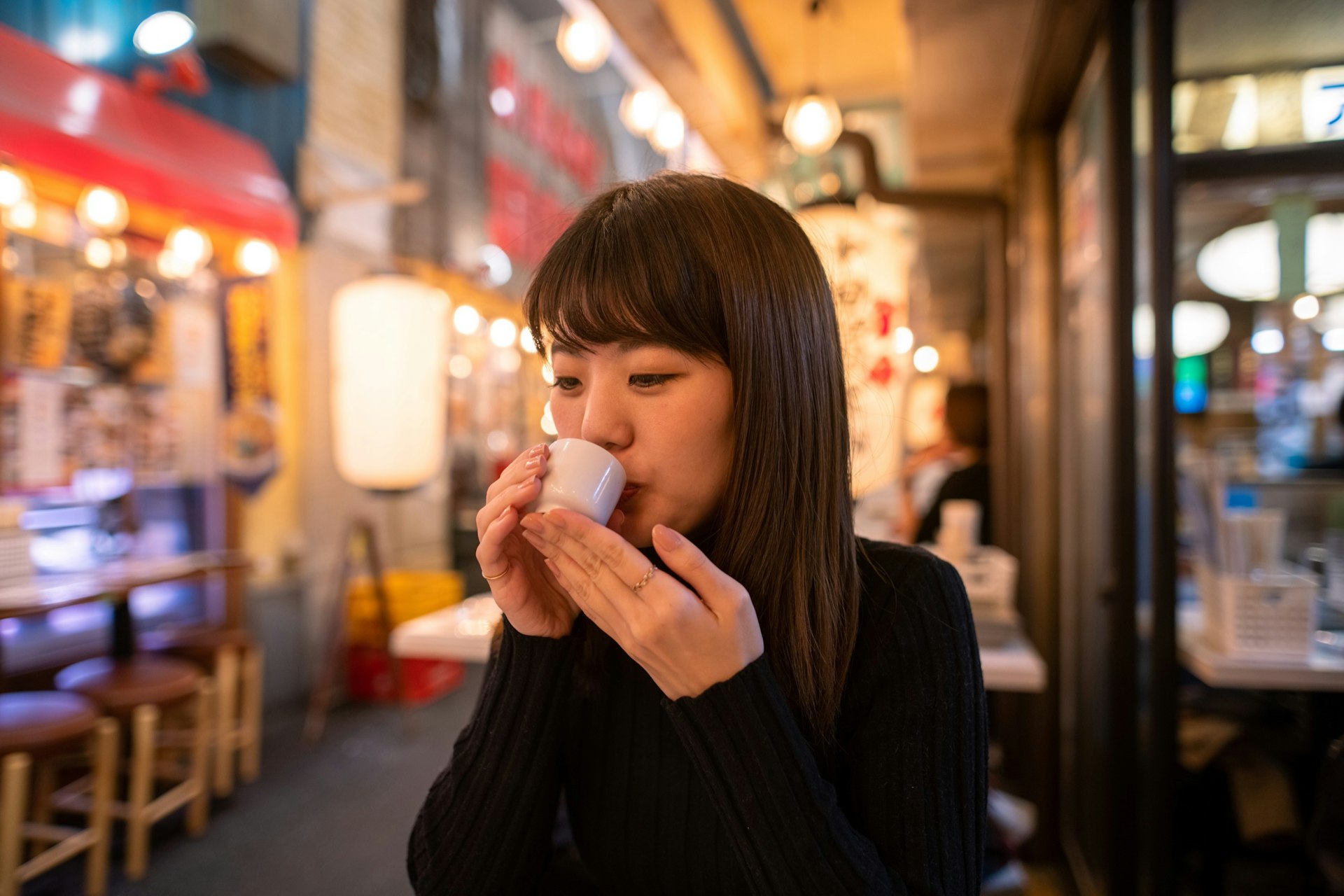Wherever you are in Japan, it seems you’re never far from a great meal. Restaurants often specialize in just one dish – perhaps having spent generations perfecting it – and pay close attention to every stage, from sourcing the freshest, local ingredients to assembling the dish attractively. And, as you’ll quickly discover, Japanese cuisine has great regional variations, a point of pride among its people.
Sample sushi, from conveyor belt to chef’s recommendation
Sushi has come to define Japanese food for many international eaters, though of course it represents only one category of Japanese cuisine. The signature dish of Tokyo – nigiri-zushi – is the style of sushi most popular around the world today: those slivers of seafood hand-pressed onto vinegar-seasoned bites of rice.
Spendier high-end sushi restaurants often create an austere, minimalist aesthetic that best enhances the gustatory experience of fresh sushi. Adventurous eaters might consider ordering omakase (chef’s choice) to discover novel delicacies you may not find anywhere else.
A cheaper, fun and relaxed way to enjoy sushi is to seat yourself at a kaiten-zushi (回転寿司), where ready-made plates of sushi travel around on a conveyor belt: pull off passing plates as they appeal to you. Your bill gets determined by the plates you’ve piled up.
A few sushi etiquette notes: sometimes – and often at higher-end places – the chef has taken great care to prepare and season the sushi to be eaten as presented; that is, don’t douse indiscriminately in soy sauce (staff will clue you in). For sushi that can be dipped in soy sauce, dunk the fish side and not the rice, which will fall apart. Also, it’s totally fine to eat it with your hands. The pickled ginger (called gari) served with sushi is for cleansing your palate between pieces.
Experience seasonal and sensory kaiseki, Japan’s haute cuisine
Kaiseki is Japan’s formal haute cuisine, where ingredients, preparation, setting and presentation come together to create a highly ritualized, aesthetically sophisticated dining experience. The key to kaiseki is peak seasonal freshness; as the ingredients should be at the height of their flavor, only subtle seasoning is used to enhance them. The table settings and garnishes too are chosen to complement the ingredients and evoke seasonality.
A wonderful way to experience an authentic kaiseki meal is at a ryokan (traditional Japanese inn). Depending on the location, the setting might be in a communal dining room with tatami (woven reed mat) floors and old-fashioned hearths or charcoal braziers at each table, or a more private, multi-course meal in one’s own dining room. Either way, each course is served to please both the eye and the palate.
Is ramen the world’s best comfort food? You decide.
Ramen originated in China, but its popularity in Japan (and beyond) is epic. If a town has only one restaurant, odds are it’s a ramen shop.
Your basic ramen is a big bowl of satisfyingly chewy egg noodles in broth, served with toppings such as chāshū (sliced roast pork), moyashi (bean sprouts) and menma (fermented bamboo shoots). The broth can be made from pork or chicken bones or dried seafood; usually, it’s a top-secret combination of some or all of the above. It will fall somewhere on the spectrum between kotteri (thick and fatty – a signature of pork bone ramen) or assari (thin and light). Ramen broth often takes at least a day to prepare, so the depth and complexity of flavor can fully integrate.
Japan’s top ramen pilgrimage sites are Fukuoka, where the specialty is tonkotsu (pork bone) ramen, and Sapporo, where the specialty is miso ramen. Wherever you find it, be sure you’ve saved room for this incredibly filling bowl of comfort food.
Eat like a Buddhist and let shōjin-ryōri surprise you
Shōjin-ryōri is a Japanese Buddhist vegetarian cuisine, which specifies no meat, fish, onions or garlic be used; instead, you’ll be served tofu prepared in more ways (and more flavorfully!) than you may have imagined possible.
Also featured in shōjin-ryōri, depending on seasonality, are sansai (wild mountain vegetables), mushrooms and mountain yam. Try it in Kōya-san, at one of the mountain monastery’s many shukubō (temple lodgings).
Indulge in wagyū at least once
Wagyū (Japanese beef) has earned cult status both in Japan and abroad, thanks to its rich intramuscular marbling, which makes for very melty, tender meat. Most wagyū comes from a breed of cattle known as Japanese Black.
Often the meat is seared at high temperature on a teppan (steel hotplate), diced and served with rice and miso soup. You can also grill strips of wagyū over coals at Korean barbecue-style places called yakiniku; eat it sukiyaki (simmered in an iron pot tableside) or shabu-shabu style (Japanese-style hotpot); or order it at steakhouses paired with wine.
All mention of premium Japanese beef comes with the following disclaimer: eat this, and you’ll be spoiled for life.

Slurp up some soba and udon
Soba are thin brown buckwheat noodles (which may or may not be cut with wheat), while udon are thick white wheat noodles. Some restaurants may specialize in one or the other; other places will serve both. In general, eastern Japan tends to favor soba while western Japan leans towards udon. There are also many regional variations.
Popular and refreshing in the summer, zaru soba or zaru udon – zaru refers to the bamboo tray on which the noodles are served – often are accompanied by a clear tsuyu (dipping sauce), either on the side or drizzled on the noodles. In colder weather, a hot bowl of soba or udon in broth or topped with tempura is a warming treat.
Cheap noodle shops are everywhere. At better shops, the noodles will be handmade from premium flours and mountain spring water (and will cost twice as much). But even at their most refined, noodles are a reasonably affordable meal.

Prowl the street markets for local delicacies
Wandering with an empty stomach in Japan’s street markets is a fabulous opportunity for finding your new favorite snack or novel regional treat. It’s a marvel to see stalls crammed with displays of intriguing goodies and enticing smells, and a small thrill to belly up to one of the few seats lined up at a counter serving some hyper-local specialty.
Go for sushi or kaisen-don (raw fish served on a bowl of rice) at one of Japan’s famous fish markets, like Tokyo’s Toyosu Market or Hokkaidō’s Hakodate Morning Market.
Head to Osaka’s Wanaka Honten to sample local specialties like tako-yaki (grilled octopus dumplings) or tako-sen – two dumplings sandwiched between sembei (rice crackers).
Kyoto’s Nishiki Market offers weird and wonderful foods that make up Kyoto cuisine. It’s in the center of town, one block north of (and parallel to) Shijō-dōri, running west off Teramachi covered arcade. Wander past stalls selling everything from barrels of tsukemono (pickled vegetables) and cute Japanese sweets to wasabi salt and fresh sashimi skewers.
Relax like the locals with happy hour at an izakaya
To immerse yourself in Japan at leisure, head to dinner at an izakaya (居酒屋), the thoroughly Japanese version of a gastropub. Typically, people go in groups to share small plates and drink nama biiru (beer on tap), but you can show up solo or in a pair and get seated at a counter.
You’ll find izakaya all over Japan, varying in style from the very homey and unpretentious to the more upscale. Posting up at an izakaya is a great way to try some Japanese-style pub food – some of which skews Western and all of which goes great with beer – and soak up the casually festive after-work vibes.
There may be a table charge, which will include a small appetizer (called otōshi) and sometimes a time limit (usually around two hours). Small plates might include kushiage (skewers of grilled chicken or vegetables), edamame (boiled, salted soybeans), tofu, salads, fries and grilled fish. Drinks are not limited to the lager on tap; sake, chūhai (hard seltzer) and iced tea are popular alternatives.

Explore the intricacies of Japanese tea
Japan is a treat for tea lovers. Here o-cha (tea) means green tea, and broadly speaking, there are two kinds: ryokucha (steeped with leaves) and matcha, which is made by whisking dried and milled leaves with water until a cappuccino level of frothiness is achieved. It’s matcha that is served in the tea ceremony; it is quite bitter, so it is accompanied by a traditional sweet.
When you order o-cha in a Japanese restaurant (it’s usually free, like water), you’ll most likely be served bancha, ordinary tea. (In summer, you might get cold mugicha, roasted barley tea, instead). After a course meal, restaurants often serve hōjicha, roasted green tea, which is weaker and less caffeinated. Department store food halls are also a good bet for quality tea to take home.
To really get to know Japanese tea, visit Kyoto, the birthplace of the tea ceremony. Visitors can either take part in a ceremony or simply pause to admire a teahouse, sadō (the way of tea). Nearby Uji is Japan’s most famous tea-producing region.

Sip sake, Japan’s national drink
What much of the world calls “sake” the Japanese call nihonshu (the drink of Japan). It’s made from rice, water and kōji, a mold that helps to convert the starch in the rice into fermentable sugars.
Sake has existed for at least as long as history has been recorded in Japan, and likely much longer. It plays an important part in a variety of Shintō rituals, including wedding ceremonies, and many Shintō shrines display huge barrels of sake, most of them empty, in front of their halls. Naturally, sake is the best pairing for traditional Japanese cuisine.
Sake can be drunk reishu (chilled), jō-on (at room temperature), nuru-kan (warmed) or atsu-kan (piping hot), according to the season and personal preference. The top-shelf stuff is normally served chilled. Sake is traditionally presented in a ceramic jug known as a tokkuri and poured into tiny cups known as o-choko or sakazuki.
A traditional measure of sake is one gō (一合), which is a little over 180mL or 6oz. In specialty bars, you will have the option of ordering by the glass, which will often be filled to overflowing and brought to you in a wooden container to catch the overflow.
Round off a meal with Japanese sweets
Sweets in Japan are traditionally considered an accompaniment for tea, though many restaurants have adopted the custom of dessert and end a meal with a serving of sliced fruit or maybe ice cream. Japanese confections are known generically as wagashi, as opposed to yōgashi, Western-style sweets like cake and cookies.
The basic ingredients are just rice and a sweetened paste of red azuki beans (called anko). Flavor (usually subtle) and design (often exquisite) are influenced by the seasons. In spring, they may be shaped like pink cherry blossoms or wrapped in cherry leaves; in autumn, they might be golden colored, like the turning leaves, or flavored with chestnut.
Okashi-ya (sweet shops) are easy to spot: they usually have open fronts with their wares laid out in wooden trays to entice passers-by.
Picking up a few pre-packaged boxes of seasonal specialty sweets at the airport is a great way to unload your leftover yen before departing. Often, what’s on offer is only available during that time of year and has a short shelf life, so gift or savor the sweets soon after your return.
Ready to plan your trip to Japan? Here are your next steps:
Check out these budget-friendly tips before you book
Save these top places to go for when you’re ready to build your itinerary
Read these key things to know before you arrive in Japan
And here are 24 of the best things to do when you get there
Destination expert Wendy Yanagihara reviewed and updated this text for accuracy and relevance. Some content has been adapted from Lonely Planet’s print edition.
